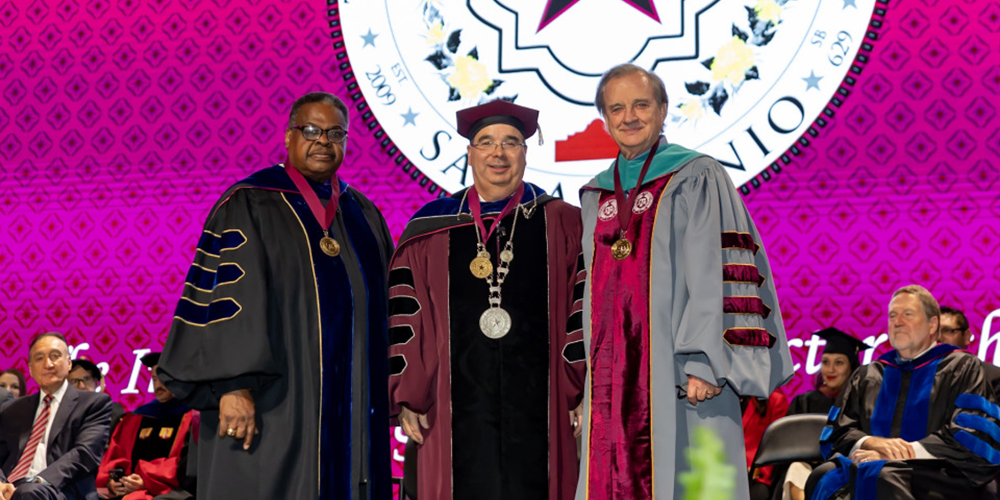Ochoa detailed his vision for the University during the welcoming ceremony
A&M-San Antonio recently celebrated the investiture of Dr. Salvador Hector Ochoa as the University’s third president. Held at the Boeing Center at Tech Port, nearly 900 people attended the formal welcoming ceremony. Guests included presidential, faculty and administrator delegates of colleges and universities, independent school district delegates, the Texas A&M University System Board of Regents, as well as A&M-San Antonio board members, academic leaders, and students.
With Henry G. Cisneros, chair of the University’s Advisory Board, serving as the master of ceremonies, the investiture provided a platform for Ochoa to share his vision for the University. He also recounted his personal story, including growing up in McAllen, Texas, as one of eight siblings. He stressed how important family has been to his success, and how he and his brothers and sisters were molded by family traditions and values.
“The dreams my family had for me are the same dreams held dear by the parents and grandparents of our students,” Ochoa told the crowd. “They share the same fears and anxieties. They face the same challenges and make the same sacrifices. But most importantly, the values of my family, of my community, are the same values as the families that entrust us with the education of their loved ones. Just like my parents did, they want them to fly, but they do not want them to forget where the nest is.”
As A&M-San Antonio’s enrollment this year surpassed 8,000 for the first time—including nearly 1,300 freshmen, about 20% higher than last year—Ochoa encouraged students to dream big. He also vowed that the University would see them through to the end of their academic journeys.
“We want our students to graduate with pride in themselves, their university, and their community,” he said. “We want our students to graduate confident that they can walk into any situation and earn the trust and respect of any group of colleagues. And of course, we want our students to graduate with the skills and the courage to engage the ever-accelerating change that will mark this century and those to come.”

Ochoa also highlighted how far the University has come since it was founded in 2009, evolving from acres of mesquite trees, cacti, and feral pigs to a beautifully developed campus that continues to grow.
“We must look forward, embracing change and the future, because the possibilities that lie ahead for this university are tremendous,” he said. “We must be intently engaged in building a university that is nimble, innovative, and future-focused. And we must do so with a strong sense of urgency. Our greatest advantage is that we are a young university, and we have a lot of room to maneuver before our choices and processes become entrenched.”
As A&M-San Antonio charts its path forward, Ochoa discussed some of the ways the University is enhancing the quality of campus life, including this semester’s launch of men’s and women’s basketball. Moreover, in January, the University will begin construction on an NCAA competition-quality track and field complex, paving the way for men’s and women’s track and cross-country teams and NCAA Division II status.
Also on the horizon is a new student union, which is being funded in part by student fees, and will serve as a central location for campus experiences.
“What I have in mind is something iconic,” Ochoa said. “Something that—like the rest of our campus—is true to the mission architecture and the rich cultural heritage of San Antonio.”
In addition to developing new campus buildings, Ochoa is also focusing on expanding the University’s academic footprint to meet future workforce needs, with an emphasis on degree production in health-related and engineering professions.
In conjunction with expanding the academic footprint, Ochoa also stressed the importance of expanding the University's research enterprise. He stressed that A&M-San Antonio is making strategic investments to expand research and highlighted current projects that delve into improving the health of minority populations, understanding the historical and cultural dynamics of Mexican Americans in the United States, and examining multicultural consumer issues in the marketplace.
Finally, Ochoa discussed how the University is strengthening the birth to post-graduate pipeline. Most notably, there’s EDUCARE, an on-campus facility that will serve as a world-class childcare center and lab school for early childhood education students. Construction on the facility is scheduled to begin in January 2025.
“I can’t imagine another university with this same wealth of possibilities,” Ochoa said. “There are Texas-sized opportunities in front of us, and there is a great deal of work yet to be done to realize them. It’s work that requires an enormous amount of passion, energy, and perhaps most importantly, heart.”